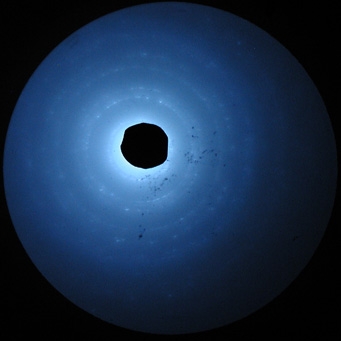What it shows:
Louis de Broglie predicted that matter under certain circumstances would exhibit wave-like properties. A proof of this is the repeat of X-ray diffraction experiments using electrons, whose de Broglie wavelengths at high accelerating potentials are similar to X-ray wavelengths. Here we accelerate electrons into crystal targets and get diffraction patterns identical to those from X-ray diffraction.

How it works:
The apparatus is a Welch Scientific 2639 Electron Diffraction Tube mounted within its 2639A container and power supply. What we have then is a controllable electron gun with built in crystal targets. The samples provided are two dimensional hexagonal pyrolytic graphite which gives a monocrystal dot diffraction pattern; polycrystalline aluminum that gives a ring pattern and polycrystalline hexagonal pyrolytic graphite which gives an intermediate (beaded ring) diffraction pattern. By setting the anode voltage between 5kV and 10kV the electron beam can be steered onto a crystal sample by horizontal and vertical controls (details in Setting it Up). Knowing the distance from the crystal target to the screen (18.16cm) an investigation into the crystal structure can be carried out using Bragg's law (examples of analyses are given in the tube handbook).
Setting it up:
Allow the tube to warm up for about five minutes with the anode voltage at around 5kV. Turn up the voltage to 7kV and scan the screen for crystals using the horizontal and vertical controls, but remember that anode voltage also affects deflection so is a third variable. Fine tune the beam with one control at a time. Fiddle with intensity and focus controls after you have located a crystal. To display, use a camera with zoom to fill a TV screen with the pattern. To cut glare on the front window from overhead lighting, use a sheet of 50cm × 75cm card as a visor. The camera also has to be protected from the central bright spot of the diffraction pattern; this can be done by sticking a (1cm diameter circular) piece of black tape over the spot when everything is aligned. Turn down the intensity until the demo is to be used.
Comments:
If you are just going for one crystal, choose the polycrystalline graphite, although all are beautiful. Our electron diffraction tube is mounted on a Tektronix scope cart which is a perfect size. It is worth warning people unfamiliar with this setup that in-the-field crystal hunting is a tricky affair! A good companion demonstration would be the optical X-ray diffraction analog.
References:
H. F. Meiners: Instructions for Catalog No.2639 (Welch Scientific Company 1963)
L. de Broglie: Phil Mag 47, 446 (1924)
C. J. Davisson and L. H. Germer: Phys. Rev. 30, 705 (1927)
W. L. Bragg: Proc. Camb. Phil. Soc. 17, 43 (1913)
G. P. Thompson: Proc. Roy. Soc. 117, 600 (1928), 119, 652 (1928)